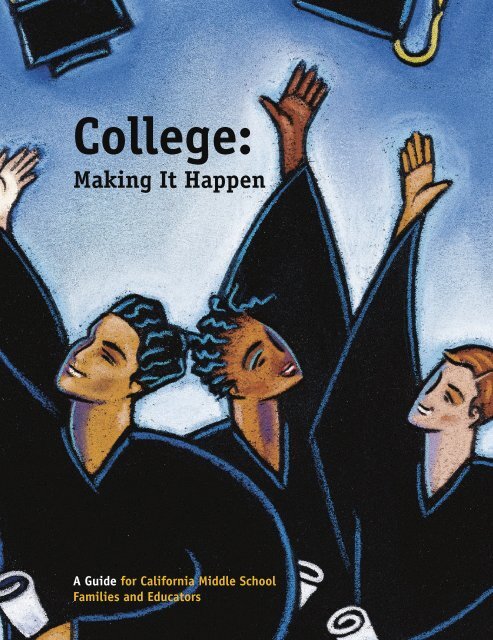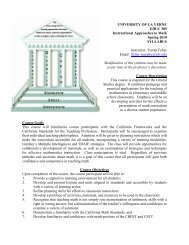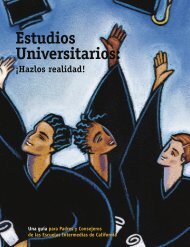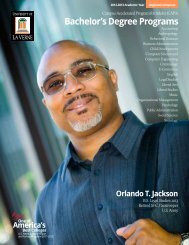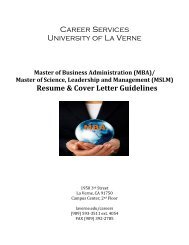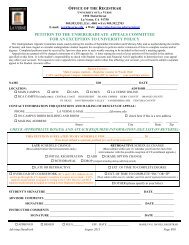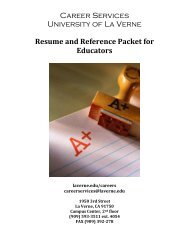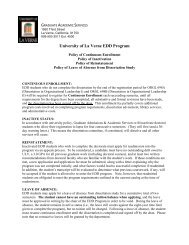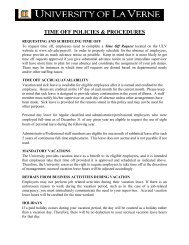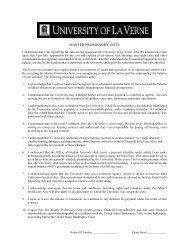College: Making It Happen - CaliforniaColleges.edu
College: Making It Happen - CaliforniaColleges.edu
College: Making It Happen - CaliforniaColleges.edu
You also want an ePaper? Increase the reach of your titles
YUMPU automatically turns print PDFs into web optimized ePapers that Google loves.
<strong>College</strong>:<br />
<strong>Making</strong> <strong>It</strong> <strong>Happen</strong><br />
A Guide for California Middle School<br />
Families and Educators
California Education Round Table<br />
A Message to Middle School Parents and Counselors<br />
from the Intersegmental Coordinating Committee<br />
To be sure that your student will be ready for college, you will need to plan ahead –<br />
particularly if you want him or her to have many choices of colleges. Don’t wait until<br />
high school to think about college. Begin when your student is in middle school<br />
(junior high school) or even elementary school. Start now!<br />
This handbook is intended to help middle school parents, guardians, counselors,<br />
and their students begin the college planning process. <strong>It</strong> is not designed to provide<br />
all the information that a student will need to apply to college. Such information can<br />
be overwhelming at this point in the planning process. This handbook is designed<br />
to assist you in beginning the college planning process which will continue through<br />
high school graduation.<br />
Good luck, stay focused, and above all, enjoy your college planning process!<br />
Ronald Ellis<br />
Chair, Executive Committee<br />
Association of Independent<br />
California <strong>College</strong>s and Universities<br />
Karen Humphrey<br />
Executive Director<br />
California Postsecondary<br />
Education Commission<br />
Jack O’Connell<br />
State Superintendent<br />
of Public Instruction<br />
California Department of Education<br />
Charles Reed<br />
Chancellor<br />
California State University<br />
Jack Scott<br />
Chancellor<br />
California Community <strong>College</strong>s<br />
Mark G. Yudof<br />
President<br />
University of California
My Career<br />
As you read the information in this booklet, please think about the careers or jobs that interest you and the kinds of<br />
<strong>edu</strong>cation that you will need to get and keep that job.<br />
When I graduate from high school, I want to be a:<br />
> career > minimum <strong>edu</strong>cation required beyond high school<br />
architect<br />
auto mechanic<br />
banker<br />
doctor or dentist<br />
fashion designer<br />
firefighter<br />
film or video maker<br />
graphic designer/<br />
computer technician<br />
electrician<br />
lawyer<br />
nurse<br />
pilot<br />
police officer<br />
school teacher<br />
video game programmer<br />
A Bachelor’s Degree (at least four years); probably a Master’s Degree (two years beyond the<br />
Bachelor’s Degree)<br />
A vocational school certificate or an Associate’s Degree from a community college (at least<br />
two years of college); concentration in mathematics<br />
A Bachelor’s Degree in a social science or business (at least four years); probably a Master’s<br />
Degree (two years beyond the Bachelor’s Degree)<br />
After a Bachelor’s Degree in a science field and a four-year graduate program that results in a<br />
medical degree (M.D.) or Degree in Dental Surgery (D.D.S.)<br />
Vocational school certificate or an Associate’s Degree from a community college<br />
(at least two years of college)<br />
Vocational school certificate or an Associate’s Degree from a community college<br />
(at least two years)<br />
A Bachelor’s Degree from a college or university (at least four years)<br />
A Bachelor’s Degree from a college or university (at least four years); concentration in<br />
computer sciences<br />
Concentration of mathematics and physics for a vocational school certificate or an<br />
Associate’s Degree from a community college (at least two years of college)<br />
After a Bachelor’s Degree in a social science field, a three-year graduate program that results<br />
in a Juris Doctor (J.D.)<br />
Concentration of science for an Associate’s Degree from a community college (at least<br />
two years) for a Licensed Vocational Nursing (LVN) Degree or a Bachelor’s Degree for a<br />
Registered Nursing Degree from a college or university (at least four years)<br />
At least a Bachelor’s Degree (at least four years)<br />
Vocational school certificate of an Associate’s Degree or a Bachelor’s Degree (at least<br />
two - four years)<br />
A Bachelor’s Degree (at least four years) and a teaching credential from a college or<br />
university.<br />
A Bachelor’s Degree (at least four years) or vocational training (at least two years);<br />
a concentration in art and computer sciences<br />
For more information, explore careers on California<strong>College</strong>s.<strong>edu</strong> by following the guide on the inside back cover of this booklet.
table of<br />
contents<br />
1<br />
page 4<br />
23<br />
page 6<br />
The Benefits of a <strong>College</strong> Education<br />
<strong>College</strong> Preparation for<br />
Middle School Students<br />
edward james olmos<br />
Host of the half-hour PBS Documentary<br />
<strong>College</strong>: <strong>Making</strong> <strong>It</strong> <strong>Happen</strong>, Edward James<br />
Olmos sets an example for young people<br />
in this country. He is an actor with a very<br />
active social conscience who has created<br />
memorable characters on television, in<br />
plays, and in movies. But his greatest<br />
enjoyment comes from influencing young<br />
people to do something with their lives.<br />
<strong>College</strong>: <strong>Making</strong> <strong>It</strong> <strong>Happen</strong> was a perfect fit<br />
for the actor as it focuses on people who<br />
forged forward, despite the odds, to graduate<br />
from college and make a difference in<br />
the world.<br />
page 14<br />
Paying for <strong>College</strong><br />
sam perez, jr.<br />
One of 11 children born to immigrant parents<br />
in the San Fernando Valley, Sam Perez,<br />
Jr. and all of his ten brothers and sisters are<br />
either college-bound or college graduates.<br />
Sam has a Bachelor’s Degree in Science and<br />
a Master’s Degree in Mechanical Engineering<br />
from the University of Southern California.<br />
Sam and his siblings, with the help of<br />
their dedicated and devoted parents, are<br />
true success stories.<br />
4<br />
page 20<br />
56<br />
page 24<br />
Types of <strong>College</strong>s and Universities<br />
Academic Resources and<br />
Organizations<br />
maria perez<br />
Maria Perez is the youngest in a family of<br />
eleven children. All ten of her older brothers<br />
and sisters have attended and graduated<br />
from college. An honor student in high<br />
school, she, too, is college-bound. The<br />
Perez family overcame the odds. As immigrants<br />
from Mexico, dad worked as many<br />
as three jobs a day to ensure his kids would<br />
have every opportunity possible, including<br />
college, first and foremost.<br />
page 28<br />
Financial Aid and Scholarship<br />
Resources and Organizations<br />
purcell keeling<br />
Why go to college? Purcell Keeling can<br />
answer that. He says it gave him the technical<br />
background to go into business. He took<br />
a variety of business classes and attributes<br />
the knowledge that he acquired during college<br />
to the success he enjoys today. Purcell<br />
owns Simply Wholesome, an establishment<br />
that caters to health-conscious individuals.<br />
<strong>It</strong> is located in Los Angeles and is the<br />
largest African-American owned and operated<br />
restaurant and store of its kind in the<br />
United States.<br />
page 31<br />
Your Future! Worksheet
1<br />
The Benefits of a<br />
<strong>College</strong> Education<br />
A college <strong>edu</strong>cation can provide your child with many<br />
opportunities for a better life.<br />
“Educating our kids is an<br />
investment in our future and<br />
our society.”<br />
edward james olmos<br />
What does a college <strong>edu</strong>cation provide?<br />
More Job Opportunities<br />
The world is changing rapidly. Many jobs rely on new technology and require more<br />
brainpower than ever. There is fierce competition for jobs that only a few years<br />
ago seemed plentiful. In your child’s working life, more and more jobs will require<br />
<strong>edu</strong>cation beyond high school. With a college <strong>edu</strong>cation, your child will have more<br />
choices of jobs and be able to earn more income.<br />
Greater Knowledge<br />
A college <strong>edu</strong>cation will increase your child’s ability to understand developments in<br />
society, to think critically, to express thoughts clearly in speaking and writing, and to<br />
make wise decisions. These skills are useful throughout a lifetime.<br />
Greater Potential<br />
A college <strong>edu</strong>cation can help increase your child’s understanding of the community,<br />
the nation, and the world as he or she explores interests, discovers new areas of<br />
knowledge, gains skills, considers lifelong goals, and becomes a responsible citizen.<br />
What is a college <strong>edu</strong>cation worth?<br />
A person who attends college generally earns more than a person who does not. The<br />
chart that follows compares average annual and lifetime salaries among individuals<br />
who did not graduate from high school, high school graduates, and college graduates.<br />
One of the important benefits of a college degree is clear: significantly greater<br />
earning potential over a lifetime in today’s competitive job market.<br />
4
Education continues to be<br />
the ticket to higher earnings<br />
Professional Degree<br />
Doctoral Degree<br />
$3.4 m<br />
$4.4 m<br />
If you are a high school student<br />
thinking about college, consider<br />
this: Someone with a Bachelor’s<br />
Degree earns nearly $1 million<br />
more over his or her lifetime<br />
than a high school graduate!<br />
The Benefits of a <strong>College</strong> Education<br />
Master’s Degree<br />
$2.5 m<br />
Bachelor’s Degree<br />
$2.1 m<br />
Associate’s Degree<br />
$1.6 m<br />
Some <strong>College</strong><br />
$1.5 m<br />
High School Grad<br />
$1.2 m<br />
Not High School<br />
Graduate<br />
$1.0 m<br />
How can I help my child see the importance of a<br />
college <strong>edu</strong>cation when it seems so far off in the future?<br />
Ask your child about his or her dreams for the future. What talents, skills, or abilities<br />
does he or she already possess? Which jobs or occupations do they most admire?<br />
What classes or activities do they enjoy? By explaining that reaching any goal<br />
takes preparation and study, you can help them appreciate the benefits of a college<br />
degree. Be willing to discuss the reasons that it is important to attend college.<br />
The earlier you begin helping your children aim toward their goals, the better their<br />
chances of reaching them.<br />
What should I know if my child is an undocumented immigrant of California?<br />
A child of an undocumented immigrant may qualify for in-state tuition rates at<br />
California Community <strong>College</strong>, California State University, or University of California<br />
campuses. He/she can save thousands of dollars if he or she has attended a<br />
California high school for at least three years and has graduated or will graduate<br />
from a California high school; or if he/she has earned a GED certificate. He/she<br />
will also need to enroll at an accredited college/university in California and to file a<br />
confidential affidavit that he/she will apply for legal residency as soon as possible.<br />
The above qualifications do not provide an undocumented student access to federal<br />
or state financial aid. For further information on admissions and financial aid for<br />
undocumented students please check the following site:<br />
http://www.californiacolleges.<strong>edu</strong>/finance/finance.asp<br />
><br />
be informed about your<br />
child’s abilities, talents,<br />
passions, and goals.<br />
be involved with developing<br />
your child’s future by<br />
supporting his or her goals.<br />
be inspired by all the benefits<br />
that a college <strong>edu</strong>cation<br />
will offer your child.<br />
5
2<br />
<strong>College</strong> Preparation for<br />
Middle School Students<br />
Discover, build, and maintain an academic foundation<br />
with your child that will bring future success in high school<br />
and college.<br />
“<strong>It</strong>’s important for parents<br />
to find out how to help<br />
their kids prepare for this<br />
endeavor.”<br />
edward james olmos<br />
When should planning for college begin?<br />
Planning for college occurs over several years and should be underway by middle school.<br />
Start early with regular savings into a college savings account such as ScholarShare,<br />
California’s 529 college savings plan. By sharing responsibility for your child’s<br />
future, planning for college should be an organized activity and begin in middle<br />
school. Parents and their children should not wait until high school to plan for college.<br />
By then, it may be too late financially and academically to apply and be admitted<br />
to the colleges that your child is really interested in attending.<br />
Specifically, what can I do to help my child prepare for<br />
college while still in middle school?<br />
Successful performance in <strong>College</strong> Preparatory Courses is the best path to prepare<br />
for college. You should assist your child in planning to take these courses and<br />
other challenging ones throughout middle and high school. Use the Your Future!<br />
Worksheet in this guide to introduce and explain to your child the various courses<br />
required for college admission that he or she should plan to take. Encourage your<br />
child to perform at the highest level.<br />
Why are these courses so important for my child?<br />
These courses provide the building blocks for access to higher and more challenging<br />
courses in later grades that are crucial for admission to, and graduation from, college.<br />
Children will have more choices when selecting a college if they take the right<br />
courses in middle and high school. <strong>It</strong> is critical to be informed, plan ahead, enroll,<br />
and succeed in required subject courses as early as the seventh grade in mathematics<br />
and language courses other than English.<br />
6<br />
Research shows that students who take Algebra and Geometry early (by the end of<br />
the eighth and ninth grades) are much more likely to go to college than students<br />
who do not. In a national sample, only 26 percent of low-income students who did<br />
not take Geometry went to college, but 71 percent of low-income students who took<br />
that course enrolled in college.
Taking Algebra early in middle and junior high school prepares high school students<br />
for Chemistry, Physics, Trigonometry, and other higher level math courses in<br />
high school. In addition, students should take at least two years of a language other<br />
than English and as many Honors and Advanced Placement courses as they can before<br />
finishing high school.<br />
A recent study found that most students casually make decisions about the courses<br />
to take in school and that they make decisions with little help from parents or<br />
school staff. By the time a child is in sixth grade, families should start talking about<br />
going to college. Many people don’t realize that a college <strong>edu</strong>cation also builds on<br />
the knowledge and skills acquired in earlier years. Your child should plan a high<br />
school course sch<strong>edu</strong>le early, preferably in the sixth or seventh grade.<br />
<strong>College</strong> Preparation for Middle School<br />
How can I ensure that my child will take these courses in<br />
middle school?<br />
Make an appointment with your child’s middle school counselor and request that<br />
your child begin taking courses such as Algebra I, Geometry, and a language other<br />
than English in the middle school years in order to plan ahead to complete the full<br />
sequence of college preparatory courses.<br />
What are the college preparatory courses?<br />
Refer to the Your Future! Worksheet in this guide. Each high school in California has<br />
its own unique list of college preparatory courses that meet university admission<br />
requirements. <strong>It</strong> is called the <strong>College</strong> Preparatory or “a-g” course list. You can help<br />
your child learn about, and prepare for, these courses in middle school.<br />
<strong>College</strong> Preparatory Course Requirements<br />
Prospective college students must give priority to completing those high school<br />
courses required for admission.<br />
Courses in mathematics and languages other than English completed in the seventh<br />
and eighth grades with grades of at least C may be counted toward <strong>College</strong> Preparatory<br />
Course Requirements. However, the principal of the high school from which a<br />
student graduates must certify that the seventh and eighth grade courses are comparable<br />
in content to those offered at the high school.<br />
7
Do different colleges require different combinations of<br />
the <strong>College</strong> Preparatory Courses for admission?<br />
All colleges and universities will regard completion of this pattern of courses favorably.<br />
See the Your Future! Worksheet for more information.<br />
Both the California State University and University of California use these specific<br />
course requirements to determine eligibility. See Chapter 4 Types of <strong>College</strong>s and<br />
Universities for a list of resources with more specific information on different colleges<br />
and their course requirements.<br />
What is a GPA?<br />
A GPA is your child’s grade point average.<br />
How is a GPA calculated?<br />
All the grades your child receives in high school are converted into numerical values:<br />
4 points for an “A,” 3 points for a “B,” 2 points for a “C,” 1 point for a “D.” The total<br />
points for all grades is then divided by the number of courses taken.<br />
How do colleges decide which students to admit?<br />
In helping your child plan for a college <strong>edu</strong>cation, it is important to know beforehand<br />
the information colleges may review when evaluating students. <strong>College</strong> admissions<br />
may be based on:<br />
• Average of grades (GPA) earned during high school.<br />
• The level of difficulty of high school courses.<br />
8<br />
• Rank in class, although not all schools calculate class rank.
• Written recommendations by teachers and guidance counselors.<br />
• Scores on national tests like the SAT Reasoning Test and SAT Subject Tests or ACT<br />
(see the Your Future! Worksheet for more information).<br />
• High achievement in academic courses throughout middle and high school.<br />
• Extent to which a student challenges him/her self.<br />
<strong>College</strong> Preparation for Middle School<br />
• Pursuit of academic interests outside of school.<br />
• Special talents like music, art, and sports.<br />
• Participation in leadership roles in school or community activities such as sports,<br />
student government, music, drama, community service, and part-time jobs.<br />
What are the tests that my child needs to take?<br />
California Standards Tests<br />
The California Standards Tests (CSTs) were developed to measure the extent to<br />
which students are mastering the State Content Standards. These tests are part of<br />
the Standardizing Testing and Reporting (STAR) Program — the state assessment<br />
system. The tests focus on English-Language Arts and Mathematics in grades 2–11<br />
and History-Social Science and Science in selected grades. <strong>It</strong> is very important that<br />
all students take part in the STAR Program. Test results are used to improve teaching<br />
that will, in turn, result in greater student achievement. Most important, students,<br />
parents, and teachers will be better informed about each individual student’s mastery<br />
of the required learning. Parents can use the test results as a basis to talk with<br />
teachers about ways to improve their child’s learning of the California Content Standards.<br />
Any differences between your child’s report card grades and the STAR test<br />
results should also be discussed because parents, guardians, students, schools,<br />
and communities share responsibility for student learning.<br />
California High School Exit Examination (CAHSEE)<br />
The purpose of the California High School Exit Examination (CAHSEE) is to ensure<br />
that students who graduate from high school have learned to read, write, and<br />
compute adequately. With a high school diploma that is based both on completing<br />
course work and passing this test, students can be confident that colleges and<br />
future employers know that they have the skills and knowledge necessary to be<br />
successful. Students can first take the exit examination in tenth grade and families<br />
should encourage their children to study and pass it the first time. However, if a<br />
student does not pass it in the tenth grade, they have several additional chances to<br />
take the test again in order to pass it before the end of the senior year. If your child<br />
does not pass the CAHSEE before graduation day, he or she will not receive a high<br />
school diploma.<br />
Additionally, the CAHSEE identifies students who are struggling so they can get<br />
the assistance that they need to pass the test and succeed in life after high school<br />
graduation. Each middle and high school in the state has special programs to help<br />
students prepare for this test. Parents should contact their child’s school to learn<br />
the ways by which their child can receive this additional support.<br />
9
California requires students to pass the California High School Exit Examination<br />
(CAHSEE) to earn a diploma. Be sure to monitor your child’s results on any test that<br />
could prevent him or her from graduating from high school.<br />
<strong>College</strong> Admissions Tests<br />
Your child is planning to attend college, so you’ll need to pay attention to tests that<br />
are usually required for college admission, such as the ACT with writing and SAT<br />
Reasoning Test. In addition, be sure that your child signs up to take the PSAT in<br />
September of the 8 th and 9 th grade year because it will help him or her prepare for<br />
the SAT in high school. Additionally, the PSAT is a key to national college search processes<br />
and scholarships.<br />
Many colleges and universities require that students take the SAT and/or ACT for<br />
the admissions process. The more times a child takes the PSAT, the greater the<br />
likelihood that he/she will be prepared for the SAT in high school.<br />
What else can I do to help my child achieve<br />
academically?<br />
• Create an academic plan with your child and his or her counselor for middle school<br />
that prepares your student to take college preparatory courses in middle and high<br />
school.<br />
• Become a knowledgeable and supportive partner in <strong>edu</strong>cational planning.<br />
• Attend the <strong>edu</strong>cation planning night at the middle school where local high school<br />
counselors present their programs and sch<strong>edu</strong>les.<br />
• While your child is still in middle school, visit the high school that he or she will be<br />
attending to meet members of the counseling staff and inform them that your child<br />
should be placed in a college preparatory sequence of classes.<br />
• Obtain the <strong>College</strong> Preparatory (“a-g”) course list from the high school your child<br />
will be attending or from the internet at www.UCOP/pathways.<strong>edu</strong>.<br />
• Using the college preparation course list for the high school, develop a tentative<br />
sch<strong>edu</strong>le of specific courses for all four years (see Your Future! Worksheet on<br />
pages 31–32 of this booklet).<br />
• Review this academic plan with your child’s counselor at least once a year.<br />
• Revise this college preparation plan each year with your child.<br />
• If you have access to a computer, have the child check out the High School<br />
Planner on California<strong>College</strong>s.<strong>edu</strong>. This is free of charge and can help you<br />
gauge your student’s success in meeting admission requirements.<br />
• Ensure that the school enrolls your child in a college preparatory sequence of classes.<br />
10<br />
• Monitor the academic progress of your child in these courses. Encourage your<br />
child to participate in academic enrichment programs offered at your school and
through local colleges and universities (See Chapter 5 Academic Resources and<br />
Organizations). These programs exist to help your child reach academic goals by<br />
offering advisement and tutoring services.<br />
• Ensure that your child passes the High School Exit Examination. Be sure to monitor<br />
your child’s results on any test that could prevent him or her from graduating<br />
from high school.<br />
<strong>College</strong> Preparation for Middle School<br />
How can I help my child maintain the academic performance<br />
required for success in high school and college?<br />
• Ensure that your child is sch<strong>edu</strong>led to take challenging academic courses which is<br />
the best way to prepare for, and succeed in, high school and college.<br />
• Ask your child questions about school, class work, and homework every day.<br />
• Personally meet all of your child’s teachers every term.<br />
• Encourage your child’s success and academic interests.<br />
• Let teachers and counselors know that your child is going to college.<br />
• Encourage your child to strive to maintain “A” and “B” grades in all classes.<br />
• Praise your child when he or she receives good grades and offer help when you<br />
think there is room for improvement.<br />
• Keep in touch with teachers and guidance counselors. Remember that your child,<br />
the counselor, teachers, and you are all on the same team and have the same goal<br />
for your child.<br />
• Ask teachers and counselors about your child. How can he or she improve? Let the<br />
counselor know that you are interested in your child’s <strong>edu</strong>cation and want to work<br />
together to get the best college preparatory <strong>edu</strong>cation possible for him or her.<br />
Your interest shows your child that you think school is important.<br />
• A child’s learning continues outside of school. Children are learning all the time<br />
and you are their teacher for much of that time.<br />
• Read aloud to each other. Start early. A love of reading starts at home and so much<br />
of <strong>edu</strong>cation depends on the ability to read.<br />
• Encourage your child to read which greatly helps children to prepare for college<br />
admissions tests and develops comprehension, vocabulary, and writing skills.<br />
Remember to turn off the television for quiet reading time.<br />
• Help your child with studying. As often as you can, review your child’s notes, assignments,<br />
and grades and ask review questions already prepared by the teacher<br />
or in textbooks.<br />
• Establish a clear set of rules and expectations with your child about acceptable<br />
behavior at school.<br />
11
• Take advantage of resources in your community. Routinely go with your child to the<br />
library, museums, concerts, plays, craft shows, and fairs. Interesting experiences<br />
expose children to new ideas and ways of understanding the world around them.<br />
These experiences will, in turn, help them understand their school work.<br />
• Emphasize to your child the importance of hard work and responsibility by giving<br />
your child reasonable jobs to do around the house. Developing good work habits<br />
early help children apply self-discipline in school.<br />
• Arrange a quiet well-lighted place for your child to study. If this is not possible at<br />
home, arrange for your child to study at a local library or study hall at school.<br />
• Encourage your child to keep his or her notes, assignments, books, supplies, and<br />
binders organized.<br />
• Establish a daily routine for your child. Set aside regular times for play, meals,<br />
study, and bedtime. By having an established daily routine, your child will learn<br />
planning and organizational skills.<br />
• Obtain reference materials (such as a dictionary and an atlas) to which your child<br />
can refer, when needed. If it is not possible to obtain such materials, it should be<br />
possible to use or borrow them from your local library.<br />
What can I do if I feel my child needs extra help?<br />
If your child is not taking initiative or is having trouble in a certain academic area,<br />
you should arrange to speak with his/her teachers. The teacher can tell you the<br />
areas in which your child needs to improve, perhaps recommending pre-college support<br />
programs, a tutor, or other means by which your child can receive additional<br />
help. If the problem is beyond any particular subject, make arrangements to meet<br />
with a school counselor or teacher who may identify other means of assistance.<br />
12<br />
As students enter the middle school years of sixth, seventh, and eighth grade, they<br />
increasingly need to take control of their own learning by organizing their assignments,<br />
seeking out help when needed, and having the self-discipline to complete<br />
assignments thoroughly and on time. Demonstrating this kind of independence and<br />
initiative is even more important for high school students who are but a step away<br />
from full adulthood.
If you feel your child could benefit from additional academic assistance or tutoring,<br />
see Chapter 5 Academic Resources and Organizations for a list of resources.<br />
How can I keep my child motivated about the benefits of<br />
a college <strong>edu</strong>cation?<br />
• Explore the Student Friendly Services website (www.californiacolleges.<strong>edu</strong>)<br />
which provides students and their parents with information about higher <strong>edu</strong>cational<br />
choices in California. The site is “the common front door” to all colleges and<br />
universities in the state and offers two major functions:<br />
<strong>College</strong> Preparation for Middle School<br />
• <strong>College</strong> exploration, including virtual campus tours, searches for campuses<br />
that meet specific criteria, and a student-campus matching capacity.<br />
• Guidance and counseling, including information on financial aid and admissions<br />
for high school and transfer students.<br />
• Take your child on field trips to local universities or colleges which is a great way<br />
for children to see and become excited about attending college.<br />
• Communicate high expectations. Emphasize the importance of learning and <strong>edu</strong>cation.<br />
Stress the value of <strong>edu</strong>cation. Children learn directly from parents whether<br />
or not to value <strong>edu</strong>cation. Studies have shown that when parents expect their children<br />
to do well in school, they do!<br />
• If one is offered, attend a <strong>College</strong> Information Day at your school or at a school in<br />
your district which is your opportunity to find out more information about college<br />
and university requirements. Make sure that you attend with your child and share<br />
the information.<br />
• Build a portfolio of your child’s work, including sample essays, artwork, math<br />
problems, even videos and computer programs. Saving your child’s work shows<br />
that you care and serves to motivate him or her by documenting the creativity, accomplishments,<br />
and progress made toward the goal of a college <strong>edu</strong>cation.<br />
• Teach your child the benefits of college by investing in California’s 529 college savings<br />
plan, ScholarShare.<br />
><br />
be informed of the courses<br />
and academic planning needed<br />
for college.<br />
be involved with your child’s<br />
<strong>edu</strong>cation and schoolwork<br />
by becoming his or her best<br />
teacher.<br />
be inspired by the achievements<br />
your child shows in<br />
preparing for college<br />
13
3<br />
Paying<br />
for <strong>College</strong><br />
Eighty percent of students going to college use financial aid.<br />
Planning ahead can help students keep their loans low.<br />
Isn’t college expensive? How am I going to pay for it?<br />
“I used pretty much<br />
everything. Scholarship,<br />
CAL Grant, university grant,<br />
PELL Grant, a couple of loans,<br />
and work study as well.”<br />
sam perez, jr.<br />
Many people who dream of attending or sending a child to college are very concerned<br />
about the costs. There are a number of programs and resources that you can use to<br />
help pay for your child’s <strong>edu</strong>cation. One of those programs is ScholarShare, California’s<br />
529 college savings plan. By saving early, you will be better prepared to pay for<br />
college. Again, information and planning are the keys.<br />
What is Financial Aid?<br />
Financial Aid is money that is made available to help students pay for the cost of attending<br />
college. Many organizations, including colleges and businesses along with<br />
both the state and federal government, are partners in investing in the <strong>edu</strong>cation<br />
and future success of today’s youth.<br />
Many students attending college in California use state, federal, institutional, and<br />
private financial aid programs to help them with the cost of college attendance.<br />
What is a Financial Aid package?<br />
This is a combination of different types of financial aid: scholarships/grants, loans,<br />
and part-time employment. <strong>It</strong> is called a package because students often receive<br />
financial aid from more than one source.<br />
What types of Financial Aid are available?<br />
Grants and Scholarships<br />
Grants and scholarships provide aid that does not have to be repaid by the student<br />
or the parent; some grants and scholarships require that recipients maintain certain<br />
academic grades. Grants are often awarded on the basis of financial need alone.<br />
Scholarships usually require certain academic achievements as well as financial<br />
need. Virtually all colleges directly provide some form of grants and scholarships<br />
which is known as institutional aid.<br />
14<br />
The CAL Grant Program<br />
If a California student graduates from high school with a “B” average, or a 3.0 grade<br />
point average (for Cal Grant A), or 2.0 (for Cal Grant B) and needs money to attend
a California college, a Cal Grant will help pay the cost of fees at public colleges and<br />
universities, vocational and technical schools, and independent (private) institutions<br />
for all qualified applicants. This grant does not have to be repaid .<br />
Paying for <strong>College</strong><br />
Educational Loans<br />
Loans are another type of financial aid available to both students and parents.<br />
The interest rate on <strong>edu</strong>cational loans is commonly lower than commercial loans.<br />
These loans are often subsidized by the state or federal government or by colleges<br />
themselves. While most students borrow to help pay part of their <strong>edu</strong>cational expenses,<br />
it is important to borrow only the amount that is absolutely necessary.<br />
Work-Study Program<br />
Many students work during the summer and/or part-time during the school year<br />
to help pay for college through the Federal Work-Study Program. This program<br />
provides part-time employment financed jointly by the federal government and the<br />
colleges. The jobs are often on campus and the money earned is used to pay for<br />
tuition/fees or other college expenses. Students usually work 10 to 15 hours a week<br />
at a guaranteed minimum wage or higher.<br />
Private Scholarships<br />
Businesses, professional groups, civic organizations, and individuals make scholarships<br />
and grants available to help students who need financial assistance to afford<br />
college. Most colleges will allow students to use private scholarships to replace<br />
loans in their financial aid package.<br />
“I Can Afford <strong>College</strong>”<br />
A web site designed to raise awareness among students and their parents about the<br />
availability of financial aid at California Community <strong>College</strong>s on a year-round basis.<br />
This site offers basic financial aid information in English and Spanish and is a gateway<br />
to connect you directly with any of the colleges in the system. The Free Application<br />
for Federal Student Aid (FAFSA) and the Board of Governors Fee Waiver (BOG-<br />
FW) forms are available on the site for self-starters. If you want free one-on-one<br />
assistance to determine the type of aid that is right for you and complete the forms,<br />
workshops and contact information for your local community college financial aid<br />
office are available so you can make an appointment.<br />
See Chapter 6 “Financial Aid and Scholarship Resources and Organizations” for a<br />
list of contacts.<br />
How much does it cost to go to college?<br />
The cost of college varies significantly and is based upon three types of expenses:<br />
Tuition and Fees<br />
“Tuition and fees” is the amount of money that colleges charge for instruction and<br />
for the use of some facilities, such as libraries. Tuition and fees can range from a few<br />
hundred dollars per year to more than $25,000. See the Your Future! Worksheet for<br />
more information.<br />
15
Room and Board<br />
“Room and board” refers to the cost of housing and food which varies significantly<br />
from campus to campus.<br />
Other Expenses<br />
Students must also pay for books, school supplies, transportation, and other living<br />
expenses. These expenses are all included when figuring the cost of <strong>edu</strong>cation and<br />
the amount of financial aid that a student will receive.<br />
In considering different colleges, students need to look at the cost of attending<br />
each one. However, it is important not to become discouraged by the “total budget”<br />
because a “financial aid package” will r<strong>edu</strong>ce the actual cost for the student and/or<br />
the parents.<br />
How much will I have to pay for my child’s<br />
college <strong>edu</strong>cation?<br />
Whether or not a student receives some form of financial aid, families are expected<br />
to contribute to their children’s <strong>edu</strong>cation, even if the contribution is a small one.<br />
Most families use a combination of resources to help pay for their children’s <strong>edu</strong>cation,<br />
including:<br />
• Money they have saved over time<br />
• A portion of their current income<br />
• Loans<br />
16<br />
• Their children’s part-time and summer earnings
Paying for <strong>College</strong><br />
Typically, families pay for college over a long period of time just as they do for homes<br />
and cars. High school counselors and college staff can help families determine the way<br />
that their contributions and financial aid sources are going to cover the cost of college.<br />
How can I plan and save so that I can help my child<br />
pay for college?<br />
Each family needs a plan that will enable them to contribute toward <strong>edu</strong>cational<br />
costs. The plan need not be complicated but should take into consideration:<br />
• What current expenses you have?<br />
• When you anticipate that your child will go to college?<br />
• How much money you can afford to set aside on a regular basis?<br />
• What amount you plan to contribute?<br />
Carefully consider your entire family’s needs and goals as you develop this plan.<br />
If your children are still young, you have the advantage of time to plan ahead.<br />
What should I know if my child is part of a military family?<br />
Military family members are considered California state residents<br />
for tuition purposes.<br />
Isn’t my child too young for us to start saving<br />
for college?<br />
If at all possible, it is wise to start saving money for college as<br />
early as possible in your child’s life.<br />
Look at the example below. Putting $5 a week in a savings account<br />
that earns 6 percent interest adds up to $3,578 in ten years.<br />
Some families save all their “loose change” by putting it in a savings<br />
account on a regular basis.<br />
Remember To Start Saving Early!<br />
If you started putting money in a savings account each week that<br />
earned 6 percent, look at what you would save!<br />
Amount<br />
per week<br />
4 Years<br />
6 Years<br />
8 Years<br />
10 Years<br />
$5<br />
$1,181<br />
$1,884<br />
$2,676<br />
$3,578<br />
$10<br />
$2,362<br />
$3,767<br />
$5,352<br />
$7,156<br />
$25<br />
$5,905<br />
$9,418<br />
$13,379<br />
$17,890<br />
17
When should my child start saving for college?<br />
If you involve your children in planning during the early years, whether that means<br />
opening a savings account for each of them or dropping pennies in the piggy bank<br />
on a regular basis, they will be more likely to take an active interest in their <strong>edu</strong>cation.<br />
As soon as they are old enough to handle the responsibility of a paying job, plan<br />
that a portion of their earnings goes into a college savings account. In this way, they,<br />
too, will be invested in their future <strong>edu</strong>cation and contribute to the goals of your entire<br />
family.<br />
Are there any tax-free savings accounts for <strong>edu</strong>cation?<br />
The ScholarShare <strong>College</strong> Savings Plan is a tax-advantaged savings program sponsored<br />
by the ScholarShare Investment Board, an agency of the State of California.<br />
Anyone can open an ScholarShare account on behalf of a student and start saving<br />
for college with an initial contribution of $50, or just $15 per month with automatic<br />
investments. Distributions are federal and state tax-free when used for qualified<br />
higher <strong>edu</strong>cation expenses at virtually all accredited colleges and universities<br />
nationwide and eligible foreign institutions. For students who earn a scholarship,<br />
the scholarship amount can be withdrawn from your ScholarShare account and the<br />
10 percent federal penalty tax would not apply. However, the earnings would be subject<br />
to any other applicable taxes, including federal income tax. For more information,<br />
visit www.scholarshare.com or call toll-free 1-800-544-5248.<br />
How can I learn more about financial aid?<br />
Attend financial aid meetings held in your school district to learn more about the<br />
basic types of financial aid and ways to apply by the deadlines. Many corporations,<br />
labor unions, professional associations, religious organizations, and credit unions<br />
provide scholarships. Contact the specific organization or main headquarters directly<br />
to apply.<br />
In addition, some organizations, particularly foundations, offer scholarships to<br />
students of specific racial or ethnic backgrounds, geographical areas, religions,<br />
genders, talent, etc. Use your nearest public library and look for directories that list<br />
such scholarships or see Chapter 6 in this handbook.<br />
What if my child doesn’t qualify or receive any grants<br />
or scholarships?<br />
All students have access to deferred, low or no-interest loans from individual<br />
colleges and the federal government. Some loan programs provide loan cancellation<br />
benefits for graduating students who teach certain subjects or teach in certain<br />
schools. Regardless of qualification, all students should apply for financial aid.<br />
18
Do scholarship or financial aid organizations charge fees<br />
for information or applications?<br />
Warning:<br />
Do not pay to apply for scholarships! Beware of scholarship scams! Students and<br />
parents should not pay for information regarding scholarships and other forms of<br />
financial aid. Be suspicious of any organization which does any of the following:<br />
Paying for <strong>College</strong><br />
• Requests a fee to apply for scholarships<br />
• Insists on your credit card or checking account number<br />
• Pressures you to act fast<br />
• Requests an advance fee upon application<br />
• Guarantees that you will win a scholarship or get a specific result from a search<br />
• Charges you a fee for any scholarship<br />
• Sends notification that you were selected for a scholarship for which you never<br />
applied<br />
><br />
be informed of the variety of<br />
financial aid available to help<br />
pay for your child’s college<br />
<strong>edu</strong>cation.<br />
be involved in the process of<br />
saving for college as early as<br />
possible.<br />
be inspired by the value<br />
and investment in a college<br />
<strong>edu</strong>cation that will continue<br />
to pay and reward your child<br />
throughout his or her lifetime.<br />
19
4<br />
Types of <strong>College</strong>s<br />
and Universities<br />
There are over three hundred colleges and universities<br />
in the State of California that are organized into five<br />
different sectors.<br />
“Thank God I have my family<br />
there. They always say we<br />
know you can do it. They see<br />
so much potential in me that<br />
sometimes I don’t even see.”<br />
maria perez<br />
What types of colleges are available in California?<br />
The State of California offers a rich and wide variety of schools, colleges, and universities.<br />
Each has its own specific requirements for admission and each grants<br />
degrees or certificates in distinct areas of study upon successful completion of the<br />
course work.<br />
What are the five different kinds of colleges<br />
in California?<br />
There are three public systems of higher <strong>edu</strong>cation that are funded through taxpayer<br />
dollars:<br />
• The California Community <strong>College</strong>s (CCC)<br />
• The California State University (CSU)<br />
• The University of California (UC)<br />
Two other types of colleges exist that are not supported by taxpayer funds:<br />
• Non-profit private colleges and universities (also known as independent colleges<br />
and universities)<br />
• Specialized for profit schools and colleges<br />
What are the requirements for admissions and the goals<br />
at these different colleges?<br />
20<br />
California Community <strong>College</strong>s (CCC)<br />
background: The California Community <strong>College</strong>s offer a wide range of academic<br />
and vocational courses leading to a variety of valuable certificates and degrees. People<br />
may train for a new career, improve their job skills, or pursue special interests. Additionally,<br />
students may complete the first two years (freshman and sophomore) of an<br />
university <strong>edu</strong>cation and transfer to any college or university to complete a Bachelor’s<br />
Degree. Please visit www.mywayintocollege.com for more information.
general entrance requirements: The California Community <strong>College</strong>s admit any<br />
high school graduate or any person 18 years of age or older. The colleges will <strong>edu</strong>cate<br />
students of all abilities to meet their goals.<br />
basic facts and figures: The California Community <strong>College</strong>s serve more than 2.9<br />
million students annually in 112 separate community colleges. Many of the 112 colleges<br />
have additional locations so that a community college <strong>edu</strong>cation is readily<br />
available throughout the state – north or south; urban or rural. A California resident<br />
can attend a community college anywhere in the state (not just the one in his or her<br />
hometown) and California residents pay only $26 per unit. The colleges offer many<br />
student support programs, including financial aid, to be sure that a college <strong>edu</strong>cation<br />
is affordable for everyone who wants this opportunity.<br />
Please visit www.icanaffordcollege.com for more information.<br />
California State University (CSU)<br />
background: The California State University (CSU) is renowned for the excellence<br />
of its faculty and programs and for its emphasis on high-quality teaching. With over<br />
two million alumni, CSU is a national leader in producing students who later earn<br />
doctoral degrees in science and engineering and it prepares about 60 percent of the<br />
teachers in the state. As the CSU carries out its mission to provide access to highquality<br />
<strong>edu</strong>cation for the students of California, CSU campuses are focused on providing<br />
<strong>edu</strong>cational opportunity for all qualified students, preparing highly qualified<br />
candidates for the job market, and responding to our state’s changing needs.<br />
general entrance requirements: First-time freshmen must be high school graduates<br />
who have completed a specified pattern of coursework and have combined<br />
grade point averages and standardized test scores that place them among the upper<br />
one-third of California high school graduates. Completion of fifteen units of <strong>College</strong><br />
Preparatory Course Requirements with grades of “C” or better is required.<br />
basic facts and figures: CSU is the nation’s largest university system (433,000 students)<br />
with 23 campuses stretching from Humboldt in the north to San Diego in the<br />
South. Each campus has its own personality, academic focus and strengths, special<br />
geographic features, and traditions.<br />
Please visit www.csumentor.com which provides middle school, high school, and<br />
community college students, their families, and counselors with important outreach,<br />
pre-admission, financial aid, and admission information via the internet. The websites<br />
of all 23 California State University campuses may be reached via<br />
www.calstate.<strong>edu</strong>, and select “Campuses”.<br />
University of California (UC)<br />
background: The University of California has an international reputation for academic<br />
excellence, with undergraduate <strong>edu</strong>cation as one of its highest priorities.<br />
Whether students are seeking a broad liberal arts <strong>edu</strong>cation, preparing for graduate<br />
study, or training for a profession, such as medicine or law, UC has literally hundreds<br />
of majors from which to choose. The faculty includes 20 Nobel Prize winners as well<br />
as winners of the Pulitzer Prize, Guggenheim Fellowships, and Fulbright Scholarships.<br />
Faculty membership in the prestigious National Academy of Sciences is the<br />
largest of any university or college in the nation. Most faculty members teach and<br />
conduct research. On the average, there is one faculty member for every 18 students,<br />
although this varies by campus and major of study.<br />
Types of <strong>College</strong>s and Universities<br />
21
general entrance requirements: UC is committed to providing a place on one<br />
of its campuses for all eligible applicants who are California residents. Eligible applicants<br />
have grades and test scores that place them in the top 12.5 percent of high<br />
school graduates statewide. Most incoming freshmen have high school grade point<br />
averages of 3.7 or above (a strong “B+” average) in academic courses and combined<br />
SAT verbal, math, and writing scores of 1800 or more, or an ACT score of at least 25.<br />
Students must complete subject, examination, and scholarship requirements and<br />
submit an application during the November filing period.<br />
basic facts and figures: Of the more than 200,000 total students who attend UC,<br />
more than 160,000 are undergraduate students. UC general campuses, where undergraduate<br />
students earn Bachelor’s Degrees, are located in Berkeley, Davis, Irvine,<br />
Los Angeles, Merced, Riverside, San Diego, Santa Barbara, and Santa Cruz. The San<br />
Francisco campus is a graduate campus for health sciences, such as medicine and<br />
dentistry.<br />
For complete information on UC entrance requirements, majors, and campuses,<br />
consult www.universityofcalifornia.<strong>edu</strong>/admissions or “Introducing the University,”<br />
which is available free for high school counselors or on the website.<br />
California’s Non-profit Independent <strong>College</strong>s and Universities<br />
background: California is home to almost 80 private, non-profit independent colleges<br />
and universities. Nine out of ten students receive financial aid; the average financial<br />
aid package is almost $23,000 in order to ensure that college is available to<br />
everyone. The campuses are diverse – 40 percent of the student body are from African-American,<br />
Asian-American, Chicano/Latino, or Native American backgrounds.<br />
Each private non-profit college and university is unique. Students can select the<br />
school and environment that best fits their individual needs. Students enroll directly<br />
out of high school or transfer from community or other colleges. Some schools are<br />
small; others are large. Some are faith-based; a few are for women only. Some focus<br />
on art, or music, or science. Some are in large cities; others are in small towns.<br />
Some have large on-campus communities; others have large commuter student<br />
populations.<br />
general entrance requirements: The admissions requirements are similar to<br />
those at the California State University and University of California systems. Some<br />
“highly selective” and other campuses have very specific requirements related to<br />
their specialties, such as art, music, or technology.<br />
basic facts and figures: Over 280,000 students attend California’s independent<br />
colleges and universities. These schools are not-for-profit institutions that are fully<br />
accredited by the Western Association of Schools and <strong>College</strong>s (WASC). Ninety percent<br />
of students attending independent colleges and universities in California are<br />
satisfied, or very satisfied, with the quality of their <strong>edu</strong>cation.<br />
22<br />
Individualized choices, unique environments, and personal attention allow students<br />
at independent colleges and universities to tailor their college experience to their<br />
own needs while obtaining the skills necessary to succeed in life. For additional information<br />
about the individual schools, go to www.californiacolleges.<strong>edu</strong>.
Specialized Schools and <strong>College</strong>s<br />
background: The proprietary or vocational sector of the higher <strong>edu</strong>cational system<br />
has over 3,000 schools and colleges which grant certificates of completion or Associate’s<br />
of Arts Degrees. Of these, 14 institutions are accredited by the Western<br />
Association of Schools and <strong>College</strong>s (WASC). As such, they have the same regional<br />
accreditation as the four other types of institutions listed above.<br />
general entrance requirements: While admissions requirements vary at each<br />
institution, students should enroll in challenging academic courses (math, science,<br />
language, English, and history) since many of the programs are technical or business-oriented<br />
in nature. As such, they require sound academic preparation in written<br />
and oral communication, math, and critical reasoning skills.<br />
basic facts and figures: Many of the specialized colleges have been in existence<br />
for over 20 years with hundreds of thousands of graduates employed in their industries.<br />
Financial aid programs are available as well as job placement assistance. The<br />
colleges are associated with industry professionals and most have boards of advisors.<br />
Are there any other types of opportunities for higher<br />
<strong>edu</strong>cation?<br />
National and International Educational Opportunities<br />
Students in California are not limited only to higher <strong>edu</strong>cation opportunities in the<br />
state. Well-prepared students also have literally thousands of institutions to choose<br />
from across the country and the world! Opportunities in the United States include over<br />
3,000 public colleges and universities and 1,600 independent colleges and universities:<br />
• Such opportunities include the Air Force Academy, Coast Guard Academy, Merchant<br />
Marine Academy, the Naval Academy, and West Point where our country’s<br />
military leaders are trained;<br />
• Other options include the Historically Black <strong>College</strong>s and Universities (HBCUs)<br />
which focus on providing a college <strong>edu</strong>cation primarily for African-American<br />
students;<br />
• Hispanic Serving Institutions (HSIs) which serve primarily Latino students; and,<br />
• Tribal colleges which serve Native American students.<br />
The <strong>edu</strong>cational possibilities in the United States and in other countries are almost<br />
endless for well-prepared students.<br />
><br />
be informed of the different<br />
colleges available and the<br />
various requirements each<br />
has for admission.<br />
be involved with the process<br />
of selecting school courses<br />
which will offer the best<br />
preparation for your child, no<br />
matter which college he or<br />
she attends.<br />
be inspired to offer support<br />
and guidance so that your<br />
child knows you are committed<br />
to the goal of a college<br />
<strong>edu</strong>cation.<br />
Types of <strong>College</strong>s and Universities<br />
23
5<br />
Academic Resources<br />
and Organizations<br />
Many programs offer support and guidance specifically<br />
to middle school students.<br />
“When our parents came to<br />
this country, they saw that<br />
there was an opportunity<br />
and they wanted to make<br />
sure we also took part in that<br />
<strong>edu</strong>cational process to better<br />
our lives.”<br />
maria perez<br />
Are there any organizations or resources available to<br />
help me assist my child in preparing for college?<br />
Please visit the Academic Preparation Program Reference and Information System<br />
(APPRIS) website at www.appris.org. The APPRIS system provides an accurate, current<br />
description of the following programs whose purpose is to prepare your student for<br />
higher <strong>edu</strong>cation. These programs offer support and guidance for middle school students<br />
and their parents. Contact your child’s counselor to find out if any of these programs<br />
are available through his or her middle school or a nearby college or university.<br />
24
Academic Outreach Programs of the California State University<br />
The California State University (CSU) Outreach Programs inform students and their families<br />
about admission requirements, financial aid, and <strong>edu</strong>cational opportunities available at CSU<br />
campuses. Campus outreach staff members provide academic and career advice as well as<br />
individual analyses of student transcripts. Each California State University campus has developed<br />
academic programs designed to meet specific regional needs.<br />
><br />
Office of the Chancellor<br />
California State University<br />
401 Golden Shore<br />
Long Beach, CA 90802<br />
Phone: 562-951-4724<br />
Advancement Via Individual Determination (AVID)<br />
AVID is designed to increase school-wide learning and performance. The mission of AVID is<br />
to ensure that all students succeed in rigorous curriculum, enter mainstream activities of the<br />
school, complete a college preparatory path, increase their enrollment in colleges and universities<br />
that offer a Bachelor’s Degree, and become <strong>edu</strong>cated and responsible participants<br />
and leaders in a democratic society.<br />
AVID Center<br />
9246 Lightwave Avenue, Suite 200<br />
San Diego, CA 92123<br />
Phone: 858-380-4800<br />
California Student Opportunity and Access Program (Cal-SOAP)<br />
The Cal-SOAP Program provides information about postsecondary <strong>edu</strong>cation and financial<br />
aid. <strong>It</strong> seeks to raise the achievement levels of students from low-income families, from<br />
schools or geographic areas with documented low or no college participation rates, or from<br />
families in which they would be the first to attend college.<br />
California Student Aid Commission<br />
P.O. Box 419030<br />
Rancho Cordova, CA 95741-9030<br />
Phone: 916-526-8920<br />
California Academic Partnership Program (CAPP)<br />
The California Academic Partnership Program (CAPP) develops “cooperative efforts to improve<br />
the academic quality of public secondary schools with the objective of improving the<br />
preparation of all students for college.”<br />
CAPP<br />
California State University<br />
401 Golden Shore<br />
Long Beach, CA 90802<br />
Phone: 562-951-4780<br />
Early Academic Outreach Program (EAOP)<br />
EAOP turns dreams of a university <strong>edu</strong>cation into reality for more than 40,000 California<br />
students from <strong>edu</strong>cationally disadvantaged backgrounds at more than 400 under-served<br />
schools. Hardworking, academically promising students get the help that they need to prepare<br />
for admission to the University of California. Challenging courses, academic advising,<br />
preparation for standardized tests, on-campus residential programs, Saturday and Summer<br />
Academies, and <strong>edu</strong>cational programs for families are the foundation of EAOP. Most EAOP<br />
students enter the program in middle school and continue through high school graduation.<br />
EAOP offices are located at each UC campus and in Fresno.<br />
Office of the President<br />
University of California<br />
1111 Franklin Street<br />
Oakland, CA 94607<br />
Phone: 510-987-9425<br />
25
Early Assessment Program (EAP)<br />
The Early Assessment Program (EAP) is designed to provide an early signal to help high<br />
school students meet college readiness standards in English-Language Arts and Mathematics<br />
before enrollment at a California State University campus. By taking the EAP in the eleventh<br />
grade, students may: a) fulfill the requirement to take English/Language Arts and/<br />
or Mathematics placement tests at the California State University and some California Community<br />
<strong>College</strong>s; b) identify the need for additional preparation to succeed in college while<br />
still enrolled in high school; c) adjust senior-year coursework to prepare for college; and, d)<br />
avoid spending time and money in college remediation courses that do not count towards a<br />
Bachelor’s Degree.<br />
><br />
Office of Chancellor<br />
California State University<br />
401 Golden Shore<br />
Long Beach, CA 90502<br />
Phone: 562-951-4724<br />
Gaining Early Awareness and Readiness for<br />
Undergraduate Programs (GEAR UP)<br />
The California GEAR UP program is a middle school model for creating a college-going culture.<br />
Program services support the adults who influence a student’s <strong>edu</strong>cation, specifically<br />
their teachers, administrators, counselors, and families. GEAR UP begins to provide services<br />
no later than the seventh grade as a solid <strong>edu</strong>cational strategy for increasing the number of<br />
students who will be prepared for, enroll, and succeed in college.<br />
California GEAR UP<br />
1100 11 th Street, Suite 10<br />
Sacramento, CA 95814<br />
Phone: 916-551-1757<br />
California GEAR UP Resources and Materials Clearinghouse: The Clearinghouse provides a<br />
single source of information, materials, and resources to support middle school <strong>edu</strong>cators,<br />
families, and students in preparing for college. The Clearinghouse is provided in three formats:<br />
a website at www.castategearup.org, a convenient Educators Kit, and an interactive,<br />
mobile “<strong>College</strong> Corner” kiosk that is available at middle schools throughout the state.<br />
Mathematics, Engineering, Science Achievement (MESA)<br />
MESA offers academic enrichment services for <strong>edu</strong>cationally disadvantaged students so that<br />
they excel in math and science, go on to college, and attain degrees in math-based fields.<br />
Over 15,000 California students are involved with MESA at the pre-college, community college,<br />
and university levels. MESA’s pre-college program, at 300 schools in over 88 school<br />
districts, assists students so that they will be eligible for admission to the most competitive<br />
colleges and universities.<br />
MESA<br />
University of California<br />
300 Lakeside Drive<br />
Oakland, CA 94612<br />
Phone: 510-987-9337<br />
MESA provides individualized academic plans, academic excellence workshops in math and<br />
science, study skills training, SAT and PSAT preparation, hands-on math and science competitions,<br />
career and college exploration, interaction with industry representatives, and parent<br />
involvement.<br />
To the extent possible by law, MESA emphasizes participation of students from groups with<br />
low eligibility rates for colleges that award Bachelor’s Degrees.<br />
26
Middle <strong>College</strong> High School (MCHS)<br />
Middle <strong>College</strong> High School (MCHS) is an unique program that enables “at-risk” students to obtain<br />
a quality high school <strong>edu</strong>cation while receiving direct access to college courses and services.<br />
A high school located on, and integrated into, the community college environment, the MCHS<br />
merges high school and community college curricula and experiences to enhance academic<br />
success significantly and provide 2,000 students with a viable path to improve their lives. High<br />
school students attend classes at a community college, earn credit toward a high school diploma,<br />
take college courses, and receive more intensive counseling attention.<br />
There are currently 13 MCHS programs in the state serving nearly 2,000 students.<br />
><br />
MCHS<br />
California Community<br />
<strong>College</strong>s<br />
Chancellor’s Office<br />
1102 Q Street<br />
Sacramento, CA 95814-6511<br />
Phone: 916-323-2768<br />
Academic Resources and Organizations<br />
PUENTE<br />
PUENTE (Spanish for “bridge”) is a national, award-winning program to increase the number<br />
of students who enroll in colleges and universities, earn college degrees, and return to the<br />
community as mentors and leaders for future generations. PUENTE trains school and college<br />
faculty to provide rigorous instruction, focused academic counseling, and mentoring by<br />
members of the community. PUENTE is co-sponsored by the University of California and the<br />
California Community <strong>College</strong>s.<br />
Transfer Programs at California Community <strong>College</strong>s<br />
“Transfer is My Way In,” sponsored by the California Community <strong>College</strong>s, is a terrific resource<br />
that makes going to college assessable, affordable, and provides a great start toward<br />
a better future for you and your family. The Transfer Centers at each California Community<br />
<strong>College</strong> are dedicated to assisting you to transfer to the university of your choice. Transferring<br />
is a smart way to save money and achieve academic goals. The transition through the<br />
community colleges to a four-year institution can make the <strong>edu</strong>cation pathways for students<br />
smoother, more enriching, productive, and ultimately lead to more success.<br />
Upward Bound<br />
Upward Bound serves high school students from low-income families, families in which<br />
neither parent holds a Bachelor’s Degree, and low-income, first-generation military veterans<br />
who are preparing to enter postsecondary <strong>edu</strong>cation. The goal of Upward Bound is to increase<br />
the rates at which participants enroll in, and graduate from, colleges and universities.<br />
All Upward Bound projects MUST provide instruction in math, laboratory science, composition,<br />
literature, and languages other than English.<br />
><br />
PUENTE<br />
University of California<br />
300 Lakeside Drive<br />
Oakland, CA 94612<br />
Phone: 510-987-9548<br />
Contact:<br />
www.mywayintocollege.com<br />
Mills <strong>College</strong><br />
5000 MacArthur Blvd.<br />
Oakland, CA 94613<br />
Phone: 510-430-2177<br />
be informed of the many<br />
resources and organizations<br />
dedicated to helping you<br />
provide the best <strong>edu</strong>cation<br />
for your child and assisting<br />
in his or her preparation for<br />
college.<br />
be involved with seeking out<br />
free assistance and options<br />
offered to supplement and<br />
guide your child’s <strong>edu</strong>cation.<br />
be inspired to take advantage<br />
of all tutoring and support<br />
that are available to assist<br />
your child.<br />
27
6<br />
Financial Aid & Scholarship<br />
Resources & Organizations<br />
There are a number of resources available to assist you<br />
in learning more about Financial Aid.<br />
“The opportunity is out there,<br />
but you have to go out and<br />
get it.”<br />
purcell keeling<br />
Where can I go for more information about Financial Aid?<br />
The contacts listed below provide information and resources on a variety of financial<br />
assistance programs which help pay for a college <strong>edu</strong>cation.<br />
californiacolleges.<strong>edu</strong><br />
916-446-7626<br />
Information About California Student Financial Aid<br />
Request the Financial Aid Workbook by calling or writing the:<br />
California Student Aid Commission<br />
P.O. Box 419026<br />
Rancho Cordova, CA 95741-9026<br />
888-224-7628<br />
web sites: www.csac.ca.gov or www.calgrants.org<br />
FAFSA on the Web<br />
www.fafsa.ed.gov<br />
Information About Federal Student Financial Aid<br />
Request Student Guide by writing to:<br />
Ed Pubs – US Dept. of Education<br />
P.O. Box 1398<br />
Jessup, MD 20794-1398<br />
or order online web site: www.ed.gov (publications)<br />
Information About Financial Aid at California Community <strong>College</strong>s<br />
www.icanaffordcollege.com<br />
ScholarShare <strong>College</strong> Savings Plan<br />
1-800-544-5248<br />
web site: www.scholarshare.com<br />
28
Information About U.S. Savings Bonds<br />
Write to:<br />
Office of Public Affairs<br />
U.S. Savings Bonds Division<br />
Washington, DC 20226<br />
1-800-4US-BOND<br />
web site: www.treasurydirect.gov/indiv/products/prod_eebonds_<br />
glance.htm<br />
Financial Aid, Scholarship Resources<br />
Are there any other sources available for information<br />
about private scholarships?<br />
Check with a librarian to find books about private sources of financial aid. School<br />
counselors may also have information about scholarship programs.<br />
The Internet provides several free Scholarship Search Programs. There is a Scholarship<br />
Search Program called FastWeb that lists awards worth over $3.4 billion. Students<br />
may access it at www.fastweb.com<br />
A good site for several sources is the Financial Aid Information Page at www.finaid.<br />
org. That site also provides information regarding scholarship matching scams.<br />
WARNING: Do not pay money to apply for scholarships!<br />
Information about Benefits for Becoming a Teacher<br />
• Teacher Loan Cancellation Provisions<br />
• Federal Perkins/National Direct and Stafford Loans<br />
www.studentaid.ed.gov (Click on Repaying)<br />
• California APLE (Assumption Program of Loans for Education)<br />
www.csac.ca.gov/doc.asp?id=111<br />
><br />
be informed of the many<br />
sources and organizations<br />
offering financial assistance<br />
for your child’s college<br />
<strong>edu</strong>cation.<br />
be involved in identifying<br />
and contacting the sources<br />
that will ensure that your<br />
child has resources to pay<br />
for college.<br />
be inspired to begin early<br />
financial planning for your<br />
child’s college <strong>edu</strong>cation.<br />
29
30<br />
notes
Your Future! Plan Ahead,<br />
Make High School Count<br />
Visit www.californiacolleges.<strong>edu</strong> and www.scholarshare.com<br />
for planning and financial aid information<br />
Take Control of Your Future!<br />
Do you want more knowledge, more job opportunities, and a lot more money? <strong>College</strong> is for you! The world is changing<br />
everyday and it is harder to find well paying jobs if you do not have a college degree... so if you want the freedom<br />
to choose a good career and earn a high salary, then you should start preparing for college while you are still in<br />
middle school.<br />
Be Prepared<br />
Right now is the best time to prepare for college. During the next four years, you need to take the right courses,<br />
including Algebra in the 8th grade, to help you get into the college that best suits your needs. The chart below lists<br />
the minimum courses that are required for freshman admission to the California State University, the University of<br />
California, and many independent colleges and universities. This pattern of courses is the same as recommended for<br />
community colleges. Talk to your counselors and teachers and use this chart to plan ahead and track your progress!<br />
> high school planning chart This planning chart belongs to:<br />
Requirements (a–g Courses) Years Required 7 th 8 th 9 th 10 th 11 th 12 th<br />
A. History/Social Science<br />
U.S. History, U.S. Government,<br />
Civics, World History<br />
Cultures, and Geography<br />
B. English<br />
C. Mathematics<br />
Algebra, Geometry, Intermediate<br />
Algebra, or Higher<br />
Level Mathematics<br />
D. Laboratory Science<br />
E. Language Other Than<br />
English (Foreign Language)<br />
F. Visual & Performing Arts<br />
Dance, Drama/Theater,<br />
Music, Visual Art<br />
G. <strong>College</strong> Preparatory<br />
Electives<br />
2<br />
4<br />
3<br />
2<br />
2<br />
1<br />
1<br />
Years. One year U.S. History or 1/2 year U.S. History and 1/2 year<br />
of U.S. Civics or American Government. CSU requires one additional<br />
year of Social Science. UC requires one additional year of<br />
World History, Cultures and Geography. UC requires one year of<br />
History/Social Science completed by the end of the 11 th grade.<br />
Years of college preparatory English composition and literature.<br />
UC requires a minimum of two years of English – three preferable<br />
– completed by the end of the 11 th grade.<br />
Years. Four years recommended. Algebra in the 8 th grade recommended.<br />
UC requires two years of Mathematics to be completed<br />
by the end of the 11 th grade.<br />
Years. CSU requires one year of Biological Science and one year<br />
of Physical Science. UC recommends three years with at least<br />
two of the following: Biology, Chemistry, Physics. UC requires at<br />
least one year of Laboratory Science to be completed by the end<br />
of the 11 th grade.<br />
Years. UC recommends three years. American Sign Language is<br />
acceptable. UC requires one year to be completed by the end of<br />
the 11 th grade.<br />
Year of the same course.<br />
One additional year of academic courses in any of the above a–g<br />
areas or a year of another approved alternative elective.<br />
UC requires at least 11 of the a–g courses to be completed by the end of the 11 th grade.<br />
31
california <strong>edu</strong>cational systems at a glance<br />
system<br />
California Community<br />
<strong>College</strong>s (CCC)<br />
California State<br />
University (CSU)<br />
University of<br />
California (UC)<br />
Independent <strong>College</strong>s<br />
and Universities<br />
number of campuses 112<br />
23 10 77<br />
college entrance test<br />
degrees offered<br />
in-state<br />
student fees/tuition<br />
(subject to change)<br />
financial aid<br />
None Required<br />
Associate degrees and<br />
vocational certificates<br />
$26 per unit<br />
(before financial aid)<br />
ACT or SAT on most CSU<br />
campuses are required for<br />
students with grade point<br />
averages under 3.00*<br />
Bachelor’s, Master’s,<br />
and Doctoral degrees<br />
Average $5,198<br />
(before financial aid)<br />
ACT with writing or<br />
SAT Reasoning Test<br />
Bachelor’s, Master’s,<br />
Doctoral, and<br />
professional degrees<br />
Average $11,285<br />
(before financial aid)<br />
ACT or SAT (check with<br />
college or university of<br />
your choice)<br />
Associate’s, Bachelor’s,<br />
Master’s, Doctoral, and<br />
professional degrees<br />
Average $28,437<br />
(before financial aid)<br />
You can afford to go to college! Financial Aid is available from colleges and universities, State and Federal governments, businesses<br />
and other organizations. All qualified students will receive a Cal Grant, which is “free” money that covers full student fees<br />
and/or living expenses at California Community <strong>College</strong>s, California State University, and University of California. Maximum Cal<br />
Grants at independent colleges and universities are $9,708; the average financial aid package at these institutions is $23,000.<br />
*Applicants who are not required to submit test scores are encouraged to take standardized admission tests for advising and for placement in appropriate courses<br />
> california colleges and universities<br />
California Community <strong>College</strong>s (CCC)<br />
• Admit all students who are 18 years old or a high<br />
school graduate<br />
• Enroll high school students under special arrangement<br />
to earn college or high school credits<br />
• Prepare students to transfer to any college or university<br />
for a Bachelor’s Degree<br />
• Have low fees and offer financial aid<br />
• Offer a wide variety of opportunities to enhance<br />
your future and enrich your life<br />
• For more information, visit the website<br />
www.californiacolleges.<strong>edu</strong><br />
www.icanaffordcollege.com<br />
California State University (CSU)<br />
• Each campus has its own personality, academic focus,<br />
and strengths<br />
• Each campus has its own special geographic features<br />
and traditions<br />
• CSU offers quality <strong>edu</strong>cation in the liberal arts and<br />
sciences and specialized training for a variety of<br />
career fields<br />
• On-campus housing is available on most campuses<br />
• For more information, visit the website<br />
www.californiacolleges.<strong>edu</strong><br />
California Education Round Table Intersegmental Coordinating Committee<br />
560 J Street, Suite 290, Sacramento, CA 95814<br />
Phone: 916/324.8593 Fax: 916/327.9172 Email: certicc@cde.ca.gov Website: www.certicc.org<br />
University of California (UC)<br />
• Each campus has its own personality, academic focus,<br />
and strengths<br />
• Offers various advanced degrees, including medicine<br />
and law<br />
• Has many nationally ranked academic and<br />
athletic programs<br />
• On-campus housing is available on all campuses<br />
• For more information, visit the website<br />
www.californiacolleges.<strong>edu</strong><br />
Independent California <strong>College</strong>s and Universities<br />
• 77 not-for-profit, fully accredited private colleges that<br />
offer over 350 different degrees<br />
• Average Financial Aid package is almost $23,000, and<br />
95% of all students receive some form of financial aid<br />
• Each school is different which offers students the opportunity<br />
to choose the type of <strong>edu</strong>cational environment<br />
that best suits their needs<br />
• For more information, visit the website<br />
www.californiacolleges.<strong>edu</strong><br />
Specialized Schools and <strong>College</strong>s<br />
• Most students 18 years of age or older are eligible<br />
for admission; however, at WASC accredited specialized<br />
colleges, it is recommended that students follow the<br />
High School Planning Chart on the reverse side<br />
• Courses or programs offered are specialized (i.e., fashion<br />
design or automotive technologies) for direct entrance<br />
into careers<br />
32<br />
This brochure is published by the California Education Round Table which is composed of the State Superintendent of Public Instruction, leaders of the<br />
California Community <strong>College</strong>s, the California State University, the University of California, and the independent colleges and universities, plus the<br />
Executive Director of the California Postsecondary Education Commission. <strong>It</strong> is distributed by the Intersegmental Coordinating Committee of the California<br />
Education Round Table. 2010/11
California<strong>College</strong>s.<strong>edu</strong> is the state’s official college and career planning website. Users learn to plan, pay, and apply<br />
for college in California and explore careers. The site has been developed for students, counselors, and parents by<br />
the Association of Independent California <strong>College</strong>s and Universities (AICCU), California Community <strong>College</strong>s (CCC),<br />
California Department of Education, California State University (CSU), and University of California (UC).<br />
><br />
Explore <strong>College</strong>s and Careers<br />
n<br />
Discover the colleges and universities in California<br />
n<br />
Determine the careers that best match your skills and interests<br />
n<br />
Search careers alphabetically or by occupational cluster<br />
n<br />
Save careers that sound interesting to you into your personal Career Portfolio<br />
n<br />
Match schools with your career interests<br />
><br />
><br />
Plan and Pay for <strong>College</strong><br />
n<br />
n<br />
n<br />
Identify the high school classes needed to meet admission requirements<br />
Learn ways to pay for college<br />
Create a personal portfolio to monitor your college planning<br />
<strong>College</strong> Admissions<br />
n<br />
n<br />
Gather information about the admission requirements at all California colleges and universities<br />
Apply online to many of the colleges and universities in California<br />
To obtain a printable guide to these parts and other portions of the California<strong>College</strong>s.<strong>edu</strong> website, click on the<br />
“Getting Started Guide” link located in the orange text box on the California<strong>College</strong>s.<strong>edu</strong> home page.<br />
Are you a parent? Don’t forget to check valuable resources under the “Information for Parents”<br />
section at the bottom of the home page.<br />
><br />
How to create a California<strong>College</strong>s.<strong>edu</strong> account<br />
1<br />
2<br />
3<br />
From the home page, click on “Create an Account” in the upper right hand corner<br />
immediately below the “Search” field<br />
Complete the requested information and select “Create My Account”<br />
Make sure that you save your user name and password information in a safe place!<br />
Log in to your account to start exploring colleges and careers!<br />
All information entered is completely secure.<br />
California<strong>College</strong>s.<strong>edu</strong><br />
is FREE to all users
2010 – 2011<br />
SCHOLARSHARE<br />
college savings plan<br />
ICC<br />
California Education Round Table<br />
Intersegmental Coordinating Committee<br />
560 J Street, Suite 290, Sacramento, CA 95814<br />
916/324.8593 www.certicc.org


